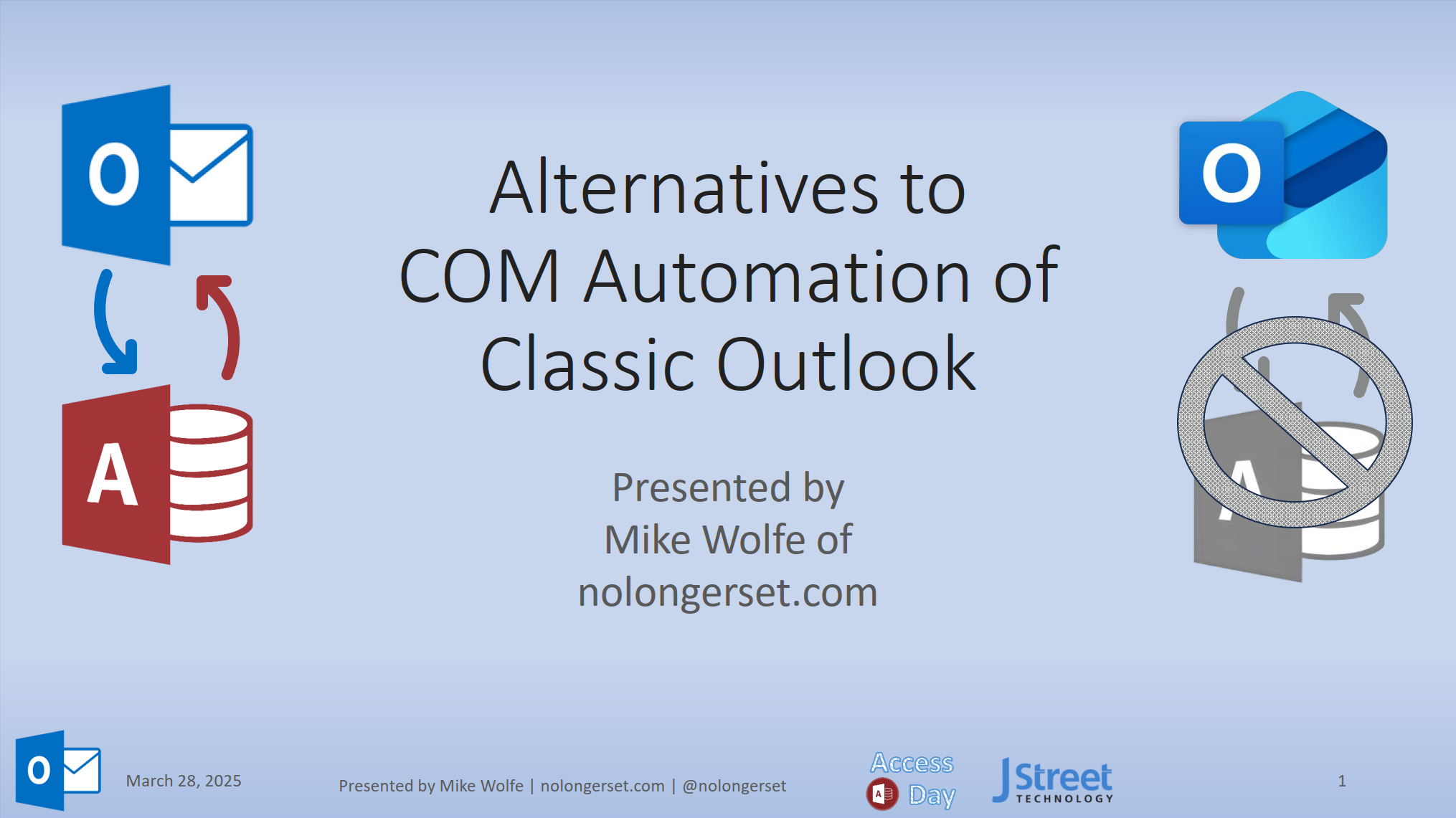BlueSpruce
Well-known member
- Local time
- Yesterday, 20:19
- Joined
- Jul 18, 2025
- Messages
- 1,109
Do these methods for sending emails work in Access365? A friend told me MS Exchange stopped working with his Access/Outlook mail merge app.
Within Access365, I need granular manipulation of incoming and outgoing classic outlook emails. I blatantly refuse to use GraphAPI with new outlook. Is MS going to intentionally deprecate ability to automate emailing via classic outlook?It isn't Access 365 that is the problem - it is "New Outlook" that won't play the mail game by the old rules.
Regarding CDO: If you can get into VBA Window >> Tools >> References and check "Collaborative Data Objects" then you can send e-mails by defining the (.To, .CC, .BCC, .From, .Body) fields you want, similar to using VBA to open an Outlook mail object. You can find CDO online if you don't have it. With CDO, you can't manipulate received mail but you can create and send mail. CDO cannot use DoCmd.SendObject because it is a simple implementation of SMTP protocol, bypassing MS MAPI (Mail Application Program Interface). If you can create the mail object with CDO and can create a file to be attached to the mail object, you can send that kind of mail with CDO.
DoCmd.SendObject depends on a mail client that supports conformance to MAPI and Component Object Model automation, and New Outlook doesn't do that. There are other mail clients such as Thunderbird that work (so I've heard) but I have never dealt with them. From what I can determine, to use DoCmd.SendObject, you must obtain a mail client compliant with the MAPI methods.
Could be that you just download "Old Outlook" and install it, or you could have a 3rd-party app. You must install this client, whatever it is, and then open Settings >> Apps and find the "default apps" link to let you make the new mail client the system-wide default mail app. After that, you should be good. Except that I don't know that Office 365 would let you do that for Classic Outlook. I would have to defer to ther forum members for that kind of info.
Quick answer: Yes!Is MS going to intentionally deprecate ability to automate emailing via classic outlook?

Coño!.. so "we are safe" with Access365 working with Classic Outlook until 2029?Quick answer: Yes!
Some information:

Access Day 2025: Outlook COM Automation Alternatives
Links and resources from my talk today for J Street Technology's in-person Access Day conference at the mothership (aka, Microsoft Headquarters).nolongerset.com
You need to revert back to classic Outlook though. New Outlook won't work.Do these methods for sending emails work in Access365? A friend told me MS Exchange stopped working with his Access/Outlook mail merge app.
At the moment it is the only solution for working with received emails if you don't have classic outlook. As a private individual there may be alternatives to new outlook which you can use, but many businesses are unlikely to move away from new outlook.I blatantly refuse to use GraphAPI with new outlook.
I just researched GraphAPI and it's indeed a PITA to set up. Meantime, I will use Classic Outlook until MS disables Exchange working with it, like they did with Outlook 2010.I get the impression that GraphAPI is a PITA to set up

I also need granular manipulation of incoming emails in Access, so what alternatives to CDO are there?.. Are there any Access AddIns for what I need?I have used CDO to send email from Access for over 20 years.
It is easy to setup but only works for sending emails. Use late binding and no additional reference is needed.
I have an example app for testing email account settings with CDO

CDO EMail Tester
Used to test sending HTML or plain text emails directly from Access without using Outlook. Attachments can also be added. Images and links can be added to HTML email. EMail settings can optionally be included in the email body.isladogs.co.uk
Agree that the Graph API is a complex alternative and whilst CDO remains available, I see no reason to change.
'For Windows 2000 or later. Requires a reference to:
' Microsoft CDO For Windows Library
' Microsoft ActiveX Data Objects 2.5 Library
Function SaveMessageTofile(ByVal PathFile, ByRef Msg As CDO.Message) As Boolean
' https://www.vbforums.com/showthread.php?879991-RESOLVED-Save-Email-as-Draft-do-not-send
On Error GoTo Err_SaveMessageTofile
Dim IDataSource As CDO.IDataSource
Dim Stream As ADODB.Stream
SaveMessageTofile = False
Set IDataSource = Msg
Set Stream = New ADODB.Stream
With Stream
.Open
.Type = adTypeText
'.CharSet = "us-ascii"
.CharSet = "utf-8"
IDataSource.SaveToObject Stream, "_Stream"
.SaveToFile PathFile, adSaveCreateOverWrite
.Close
End With
SaveMessageTofile = True
Exit_SaveMessageTofile:
Exit Function
Err_SaveMessageTofile:
MsgBox Err.Description, vbOKOnly + vbExclamation, "Error"
Resume Exit_SaveMessageTofile
End Function
'For Windows 2000 or later. Requires a reference to:
' Microsoft CDO For Windows Library
' Microsoft ActiveX Data Objects 2.5 Library
Function LoadMessageFromFile(ByVal Path, ByRef Msg As CDO.Message) As Boolean
On Error GoTo Err_LoadMessageFromFile
Dim Stream As ADODB.Stream, iMsg As CDO.Message, IDataSource As CDO.IDataSource
LoadMessageFromFile = False
Set Msg = Nothing
Set Stream = CreateObject("ADODB.Stream")
Stream.Open
Call Stream.LoadFromFile(Path)
Set iMsg = CreateObject("CDO.Message")
Set IDataSource = iMsg.DataSource
Call IDataSource.OpenObject(Stream, "_Stream")
Set Msg = iMsg
LoadMessageFromFile = True
Exit_LoadMessageFromFile:
Exit Function
Err_LoadMessageFromFile:
MsgBox Err.Description, vbOKOnly + vbExclamation, "Error"
Resume Exit_LoadMessageFromFile
End FunctionGreat questions!... Answers from Microsoft?.. That's a roll of the dice since they have a history of changing things they have announced.One thing I'm not clear about with classic outlook - support ceases in 2029. But does that mean classic outlook will stop working? Support for access 2010 ceased whatever time ago, but it still works, as do earlier versions of windows. The bigger risk to me, supporting a number of commercial clients, is that it wont be possible to install classic outlook when they buy new computers. So I need a viable solution - with the added complication that for a period of time, some users will have classic outlook and some new outlook.
It also seems that you cannot have classic and new installed side by side which makes testing difficult since GraphAPI requires new outlook style connection to the email server (unless I've got that wrong?)
I understand that you can manually drag and drop emails from new outlook to a folder or folders where it is saved as a msg file - same as classic. OK requires manual intervention to make that happen, but I'm just playing with the idea that if the relevant library files can be installed in the VBA, it will be possible to open the msg file to extract attachments etc.
The other way of looking at emails is sql - fine for reviewing the sender/header/message/etc, but not able to see attachments. However I somehow doubt that will work with new outlook
It also seems that you cannot have classic and new installed side by side which makes testing difficult since GraphAPI requires new outlook style connection to the email server (unless I've got that wrong?)
Is new outlook a browser based webmail site, or is it a client executable app installed on desktops?You can have both Classic & New Outlook. I have that in Windows 11 on 2 machines though only use Classic
Hi ColinVery few apart from Graph API
I believe some people have used Thunderbird with Access but I've never tried
Can you use Application.Object with Thunderbird client so Access can manipulate incoming/outgoing mail?Hi Colin
I have used Thunderbird with Access and it works a treat.
